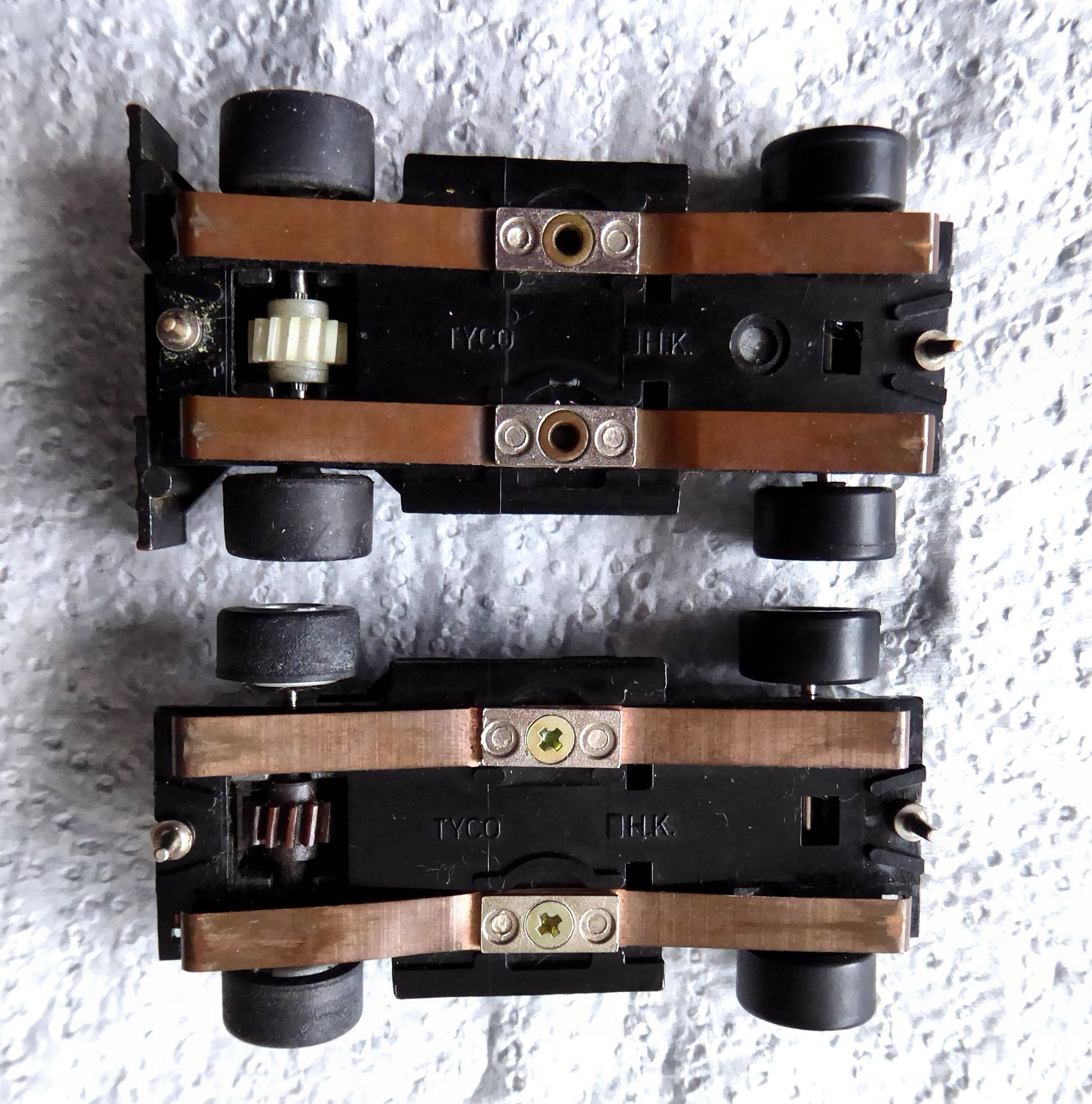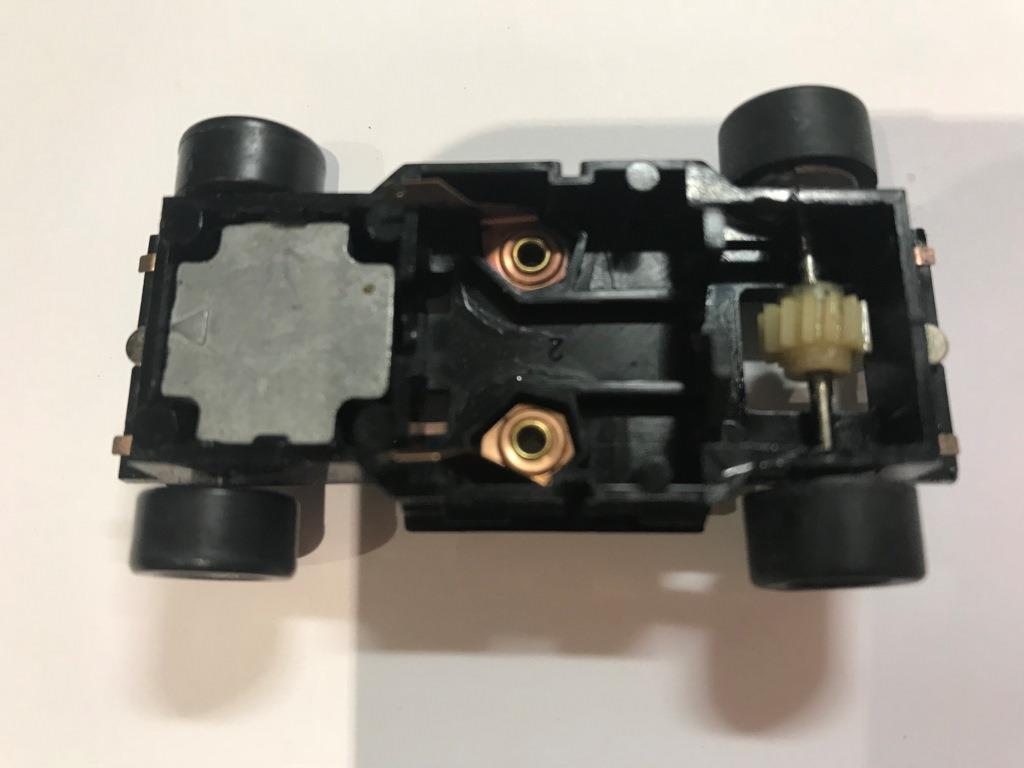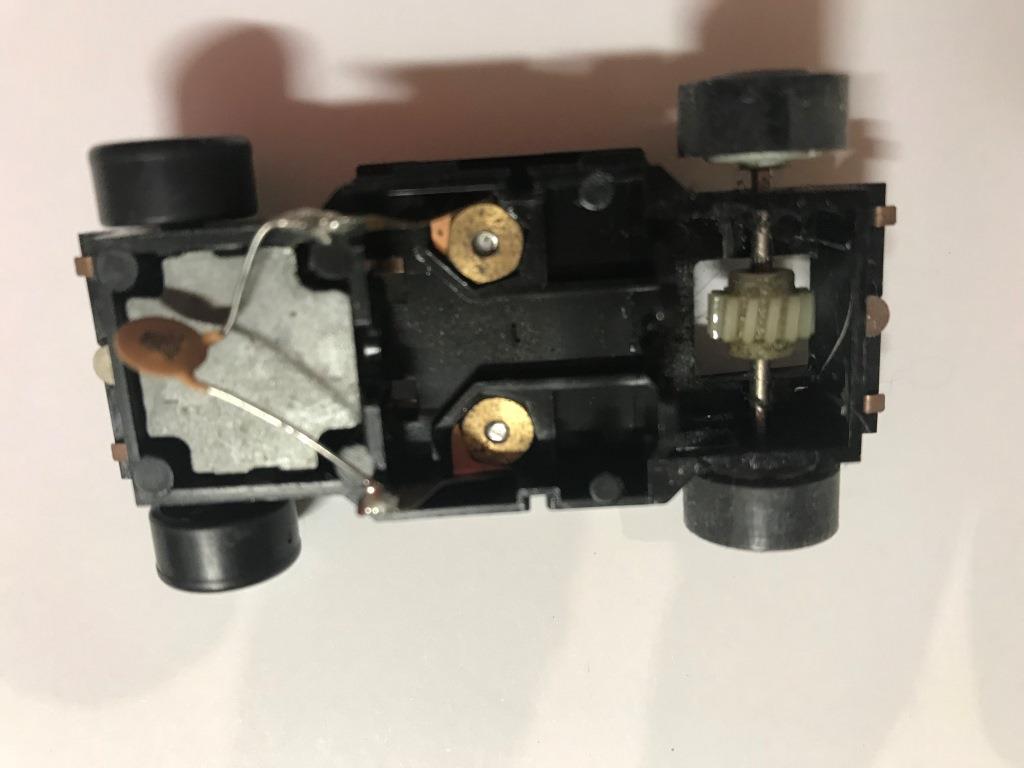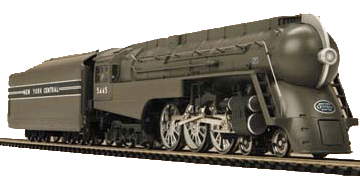|
|
 Posted - May 25 2018 : 05:58:58 AM Posted - May 25 2018 : 05:58:58 AM




|
Thanks to helping out Highwayman97 with his truck/railroad exhibit at the Gaydon Slot Car Festival over May 18th - 20th I've spent some time sorting out my US Trucking stuff and - for the first time in 25 years - noticed that a small number of chassis have the pickups rivetted in place, rather than being held by machine screws.
No difference in the plastic chassis mouldings as far as I can see and I'm afraid chassis/body combos get changed around on a whim, so there's no clue from the body/chassis combo which came first, or when the change was made.
I did look for markings on the chassis as Tyco sometimes put start dates on a new version and more often than not had the Country of origin moulded in too - but can't see any specific indicators, just the generic TYCO HK, which appears to be the same on all the all US-1 chassis I can access at the moment.
The colour of the worm drive on the back axle isn't an indicator either, as both types of chassis use either the white or brown worm crown wheel.
Oh, hang on. The rivetted chassis has a round, stepped, hole about 1/4" back from the square hole at the front end of the chassis and one, or two, 'pips' or dots on the chassis just between the square and round hole. (On their racing chassis, pan or slim, Tyco used such dots and check marks to identify the source and mould different parts of these chassis came from.) I checked Third Wheel and 6-wheeler chassis and it's true of both.
Rivets - extra round hole, one or two pips or dots on the chassis, smaller than a pin head.
Machine screw fasteners - no round hole, no dots.
Anyone got any idea which came first - and whether it's possible to change the rivetted pickups without drilling out the rivets please?

Doug
Edited by - Top Down on May 25 2018 06:36:06 AM
|
Country:  United Kingdom ~
Posts: 18 ~
Member Since: May 22 2018 ~
Last Visit: June 26 2018 United Kingdom ~
Posts: 18 ~
Member Since: May 22 2018 ~
Last Visit: June 26 2018
|
 Alert Moderator
Alert Moderator
|
|
|
|
 Posted - May 25 2018 : 06:15:39 AM Posted - May 25 2018 : 06:15:39 AM




|
Doug,
Thanks for posting this. I have just crawled through my attic to look in my sets, but despite the different sets and box styles, the vehicles all have screw fixings.
As you said yoursef, it is either an earlier or late version, or an assembly difference based on geography.
I guess it would be cheaper and involve less handling to use rivets, but I am sure Tyco supplied pick up strips as a spare part, so the rivets seem illogical.
As you say bodies can be easily swapped but hopefully someone will have some riveted ones, whose provenance they can vouch for!
James
Edited by - Highwayman97 on May 25 2018 06:16:19 AM
|
Country:  United Kingdom ~
Posts: 128 ~
Member Since: December 10 2016 ~
Last Visit: December 04 2020 United Kingdom ~
Posts: 128 ~
Member Since: December 10 2016 ~
Last Visit: December 04 2020
|
 Alert Moderator
Alert Moderator

|
|
|
|
 Posted - May 25 2018 : 10:51:29 AM Posted - May 25 2018 : 10:51:29 AM




|
Normally, the rivets are a sign of cost cutting and are of a more recent development (newer).
The cost and time factor for riveting is a lot less then using a machine screw. The additional
round hole is probably a guide hole for the machine to properly align the chassis for the
machine to place and rivet the pickups. Just my observance over the years on various types
of models.
The screws would probably be the earlier model.
Edited by - oldtimer52 on May 25 2018 10:52:45 AM
|
Country:  USA ~
Posts: 865 ~
Member Since: September 23 2014 ~
Last Visit: May 01 2023 USA ~
Posts: 865 ~
Member Since: September 23 2014 ~
Last Visit: May 01 2023
|
 Alert Moderator
Alert Moderator

|
|
|
|
 Posted - May 25 2018 : 1:24:59 PM Posted - May 25 2018 : 1:24:59 PM




|
Makes sense. Thanks for that.
Doug
|
Country:  United Kingdom ~
Posts: 18 ~
Member Since: May 22 2018 ~
Last Visit: June 26 2018 United Kingdom ~
Posts: 18 ~
Member Since: May 22 2018 ~
Last Visit: June 26 2018
|
 Alert Moderator
Alert Moderator

|
|
|
|
 Posted - May 25 2018 : 5:10:17 PM Posted - May 25 2018 : 5:10:17 PM




|
 
|
Country:  USA ~
Posts: 11536 ~
Member Since: December 09 2013 ~
Last Visit: November 14 2025 USA ~
Posts: 11536 ~
Member Since: December 09 2013 ~
Last Visit: November 14 2025
|
 Alert Moderator
Alert Moderator

|
|
|
|
 Posted - July 01 2018 : 5:42:50 PM Posted - July 01 2018 : 5:42:50 PM




|
Today I had a chance to photograph both the rivetted and unrivetted chassis without the motors in place:
First the Rivetted version:

Then the screw and nut version:

This seems to show (to me) that although there are subtle molding differences, apart from the fixing method. It looks like both chassis could take the hexagonal nuts?
Or can you see something I can't?
I am going to add my own theory now. The rivetted one is earlier. I presume this because the plastic surround strip where the rivet sits is thin. On the screwed version it is thick. Now you can imagine that when they first introduced the screwed ones, they found the thin wall strip was not strong enough to stop the nut rotating when tightened...
However, if you are arguing that the screw version came first, I can see no reason at all why they would remove the strengthening, can you?
James
Edited by - Highwayman97 on July 01 2018 5:59:44 PM
|
Country:  United Kingdom ~
Posts: 128 ~
Member Since: December 10 2016 ~
Last Visit: December 04 2020 United Kingdom ~
Posts: 128 ~
Member Since: December 10 2016 ~
Last Visit: December 04 2020
|
 Alert Moderator
Alert Moderator

|
|
|
|
 Posted - July 01 2018 : 7:02:32 PM Posted - July 01 2018 : 7:02:32 PM




|
However, as George Gershwin wrote - it ain't necessarily so:
If we agree that the Stomper Chassis was the last type to be introduced in the range, we would expect this to look like the screw and nut type, wouldn't we?
Well, sadly, it doesn't!
It has screws and nuts but looks just like the rivetted type......
So either the Stomper made use of a modified early mold that had previously been put back in store after the early rivetted chassis were made but found to unsuccessful....
OR
The rivetted type did indeed come right at the end of the range and the Stomper chassis kind of proves this,...........or not.......
In the words of the Beach Boys - God Only Knows!
james
Edited by - Highwayman97 on July 01 2018 7:03:24 PM
|
Country:  United Kingdom ~
Posts: 128 ~
Member Since: December 10 2016 ~
Last Visit: December 04 2020 United Kingdom ~
Posts: 128 ~
Member Since: December 10 2016 ~
Last Visit: December 04 2020
|
 Alert Moderator
Alert Moderator

|
|
|
|
 Posted - July 01 2018 : 11:34:15 PM Posted - July 01 2018 : 11:34:15 PM




|
After looking at the photos of both, the screw frame is the earlier manufacture. If you'll noitce,
there is a capacitor soldered across the pickups. This was put there to keep the motor from
causing interference with radio and tvs. The constant switching of the polarity in the motor
created an spike that interfered with radio and tv waves. It was the same way with the earlier
automobiles and their ignition systems. This was no longer needed in the later production
motors as the motors were redesigned to prevent that interference from being generated to
begin with.
If you'll notice that a number is imprinted in the center of the frame. The bottom one has a "1"
and the top one has a "2". That usually indicates that the model mold has been modified. The riveted contacts have a thin wall because the thickness was not needed to hold the contact or rivet in place. This also saved plastic material. Not over a small production run, but over a large run
the small amount saved really added up.
|
Country:  USA ~
Posts: 865 ~
Member Since: September 23 2014 ~
Last Visit: May 01 2023 USA ~
Posts: 865 ~
Member Since: September 23 2014 ~
Last Visit: May 01 2023
|
 Alert Moderator
Alert Moderator

|
|
|
|
 Posted - July 02 2018 : 02:07:30 AM Posted - July 02 2018 : 02:07:30 AM




|
That is interesting, Thank you!
Those are good logical well reasoned arguments.
I don't know if the motor was re-designed though, as the range was only around for less than six years from 1981 to 1986.
However, in my own experience of studying models the number on a molding normally reprasents different shots from a multiple mold. I haven't studied this particular item exhastively , but it seems to me that two impressions (at least) were produced with each injection of plastic..... Each impression on the mold carries it's own number, to help quality control and tracing any defects. These numbers can go quite high depending on how small the object to be molded is and how many impressions are on the mold
That is certainly how it works with other makes I have followed.
James
Edited by - Highwayman97 on July 02 2018 04:27:15 AM
|
Country:  United Kingdom ~
Posts: 128 ~
Member Since: December 10 2016 ~
Last Visit: December 04 2020 United Kingdom ~
Posts: 128 ~
Member Since: December 10 2016 ~
Last Visit: December 04 2020
|
 Alert Moderator
Alert Moderator

|
|
|
|
 Posted - July 02 2018 : 4:51:21 PM Posted - July 02 2018 : 4:51:21 PM




|
The reason that the companies put the "spark arrestor" on the motors and such was not voluntary.
Back in the 60's when railroading and road racing started to be come popular, the interference
became such a problem that the government REQUIRED them to take that step. Back then, the
TV and Radio stations were broadcasting on UHF/VHF and AM bands. The spark that came from
the polarity switching created a static in the broadcast bands that was annoying to say the least.
My first train and racing sets would send the TV into fits of video and audio static and really piss
my family off. If the houses were close enough together, it even got the neighbors.    
When the Radio started using the FM band and the TV went more to cable and satellite, the problem went away because the sparking didn't bother those frequencies.
|
Country:  USA ~
Posts: 865 ~
Member Since: September 23 2014 ~
Last Visit: May 01 2023 USA ~
Posts: 865 ~
Member Since: September 23 2014 ~
Last Visit: May 01 2023
|
 Alert Moderator
Alert Moderator

|
|
|
|
 Posted - July 02 2018 : 11:02:31 PM Posted - July 02 2018 : 11:02:31 PM




|
I've noticed that, even with antenna TV, the locomotives that used to cause interference to the analog TV signal don't seem to affect the digital signal now used. This is good, because back in the analog days, a capacitor across the motor of my worst offender didn't fix the problem, anyway.
Carpe Manana!
|
Country:  USA ~
Posts: 2411 ~
Member Since: September 17 2013 ~
Last Visit: November 22 2025 USA ~
Posts: 2411 ~
Member Since: September 17 2013 ~
Last Visit: November 22 2025
|
 Alert Moderator
Alert Moderator

|
|
|
|
 Posted - July 03 2018 : 12:48:04 AM Posted - July 03 2018 : 12:48:04 AM




|
On some of them, the capacitor required was larger than the locomotive.  
|
Country:  USA ~
Posts: 865 ~
Member Since: September 23 2014 ~
Last Visit: May 01 2023 USA ~
Posts: 865 ~
Member Since: September 23 2014 ~
Last Visit: May 01 2023
|
 Alert Moderator
Alert Moderator

|
|
|
|
 Posted - July 03 2018 : 06:21:45 AM Posted - July 03 2018 : 06:21:45 AM




|
Guys,
As you say, this TV Supression thing happened in Britain and Europe too, and my recollections are it was the late 50s and early 60s, which fits in with what others have said here.
I can recall getting hold of what was even then (in the early 70s) and old unsurpressed Tri-ang loco, which I ran in the attic to the severe annoyance of my parents who were trying to watch their VHF TV!
However, US-1 came almost 20 years after these measures appeared. The fact that some trucks have the capacitor and some don't is frankly odd, but I don't think this relates directly to the two distinctly different types US-1 chassis moldings.
James
|
Country:  United Kingdom ~
Posts: 128 ~
Member Since: December 10 2016 ~
Last Visit: December 04 2020 United Kingdom ~
Posts: 128 ~
Member Since: December 10 2016 ~
Last Visit: December 04 2020
|
 Alert Moderator
Alert Moderator

|
|

